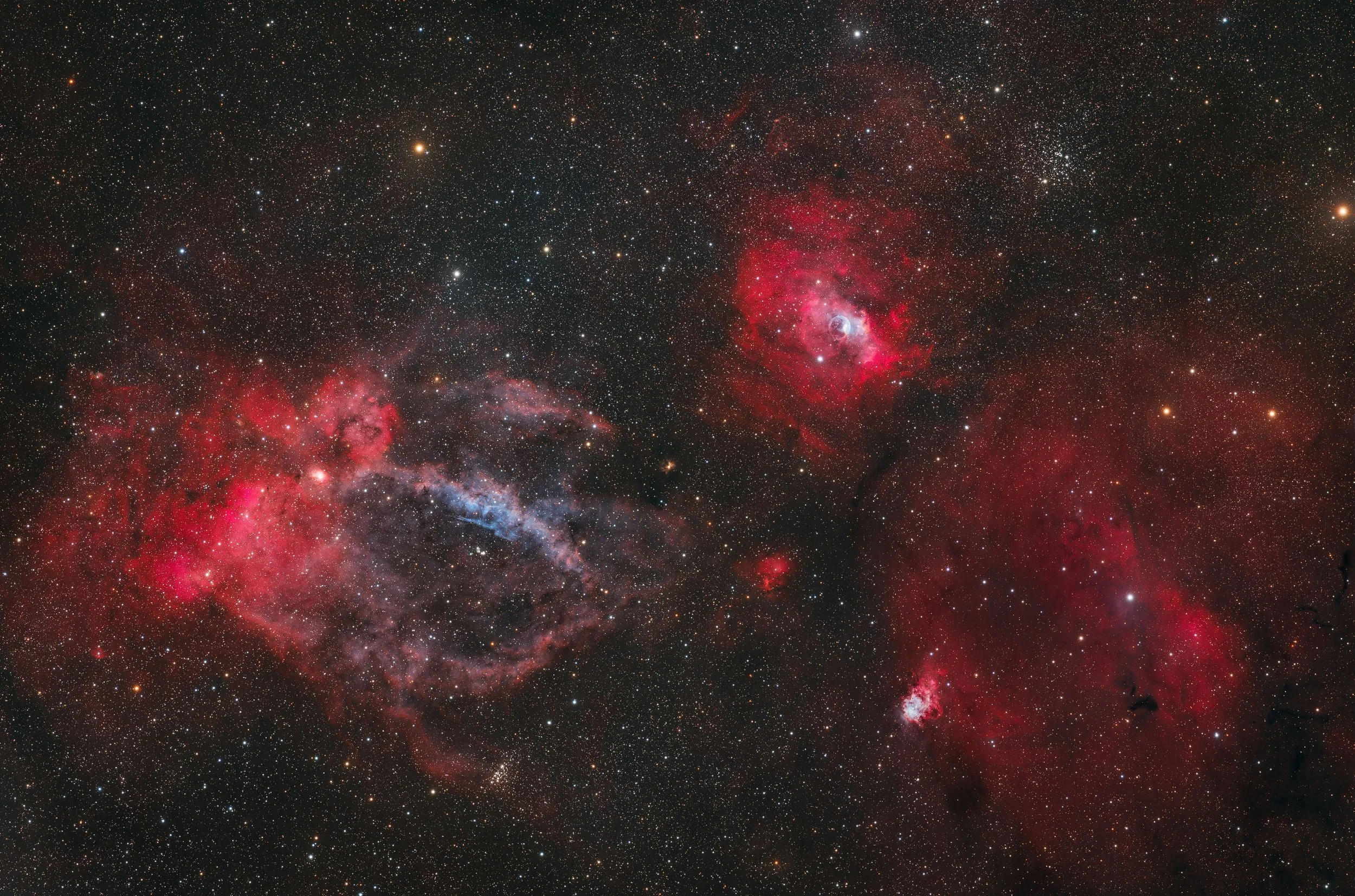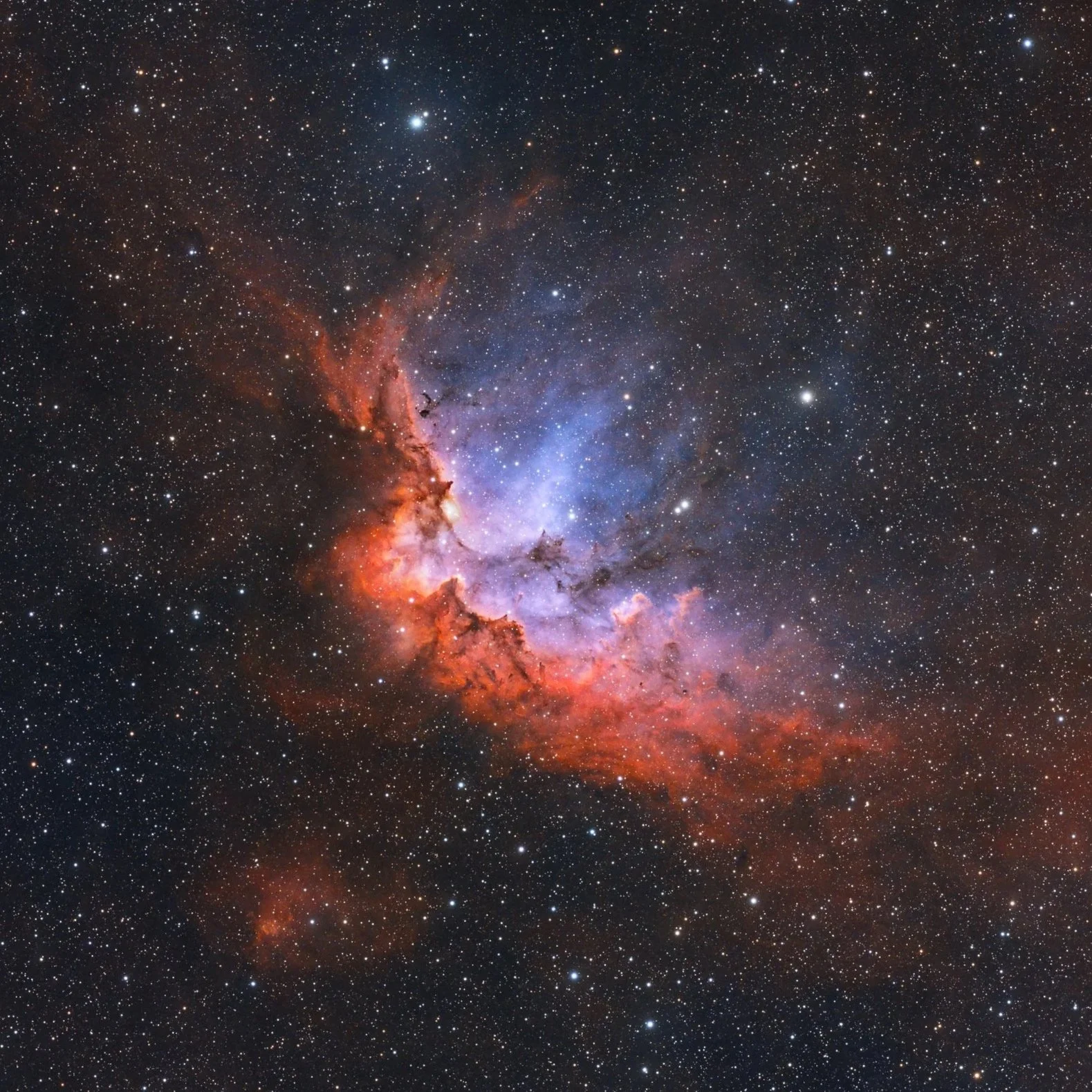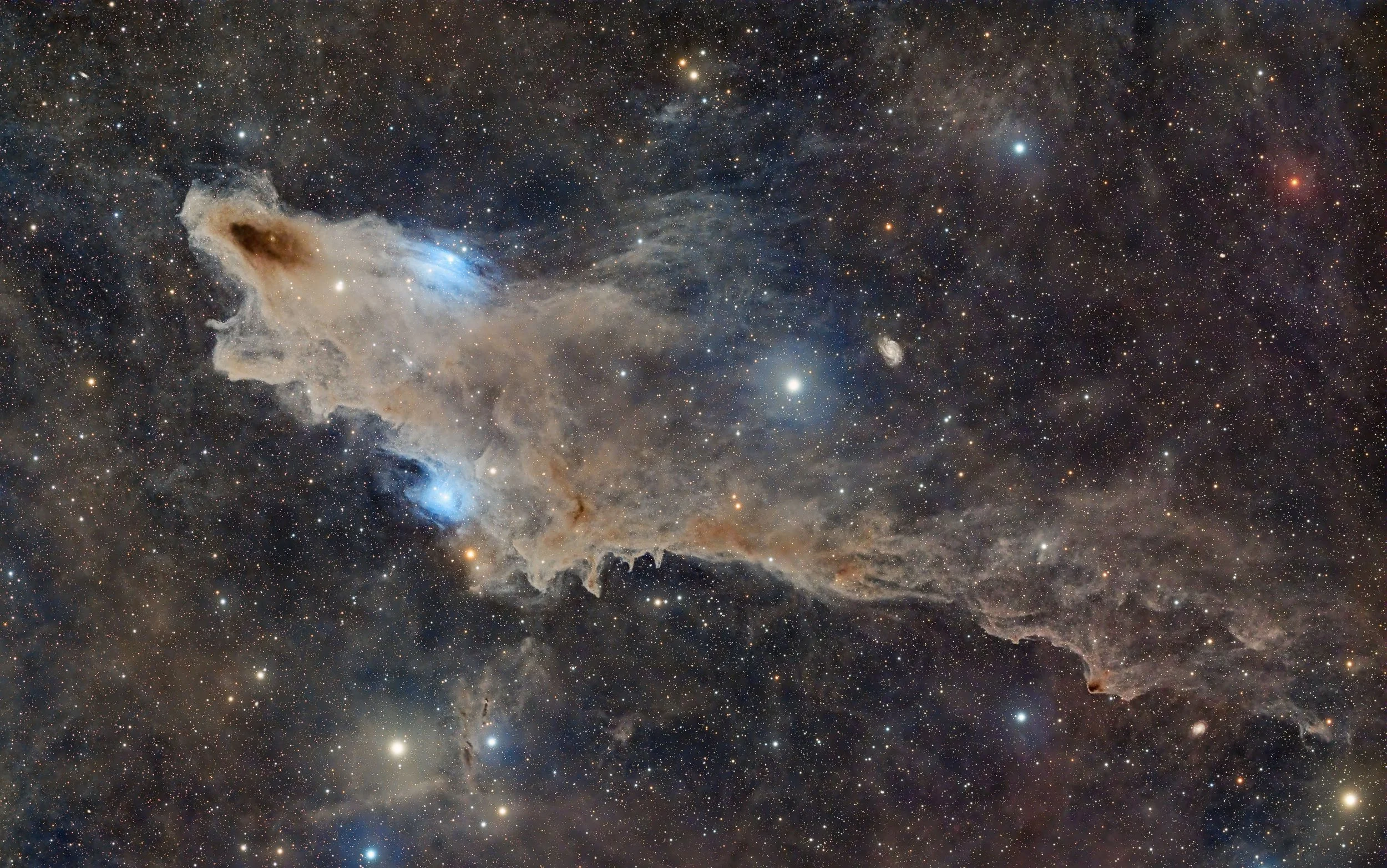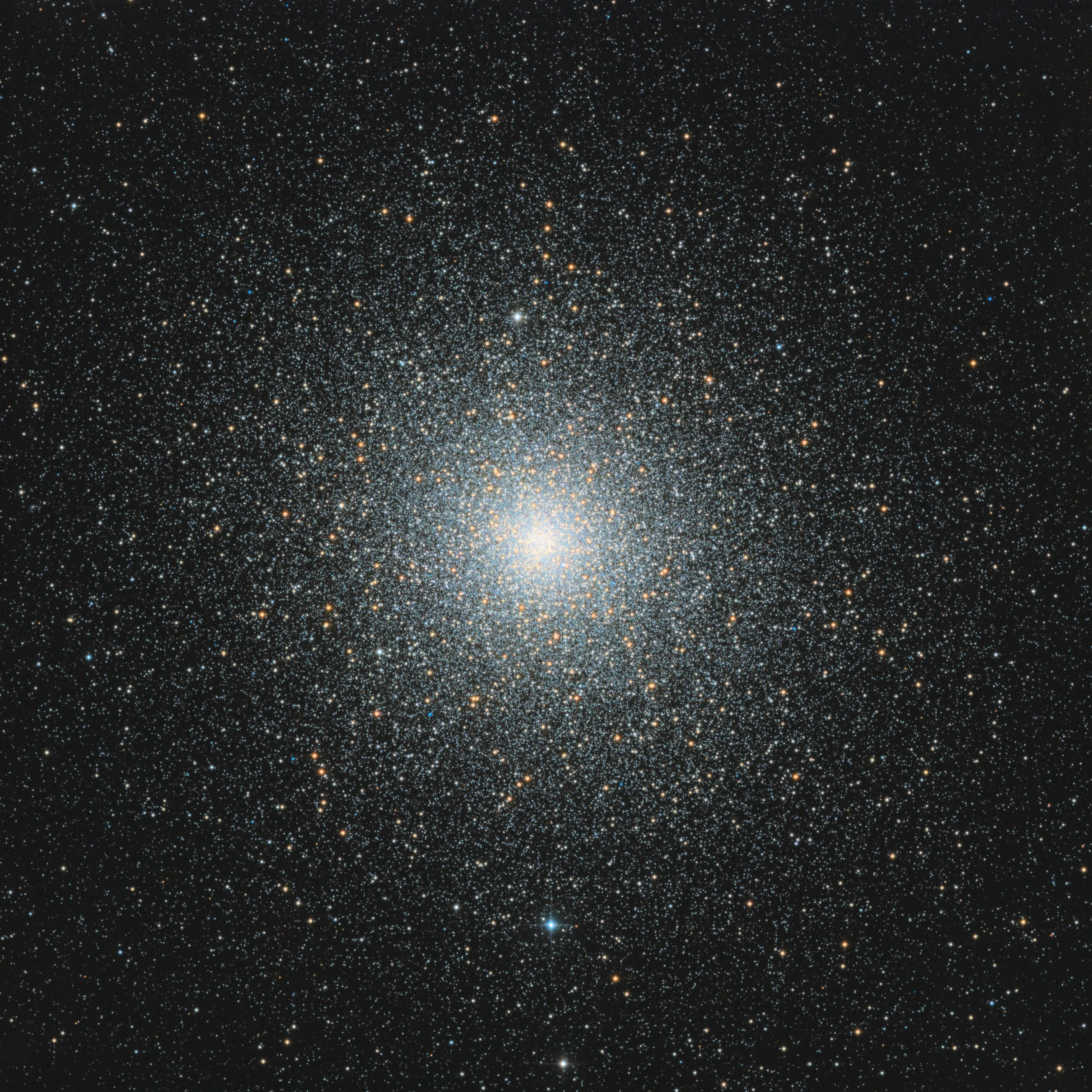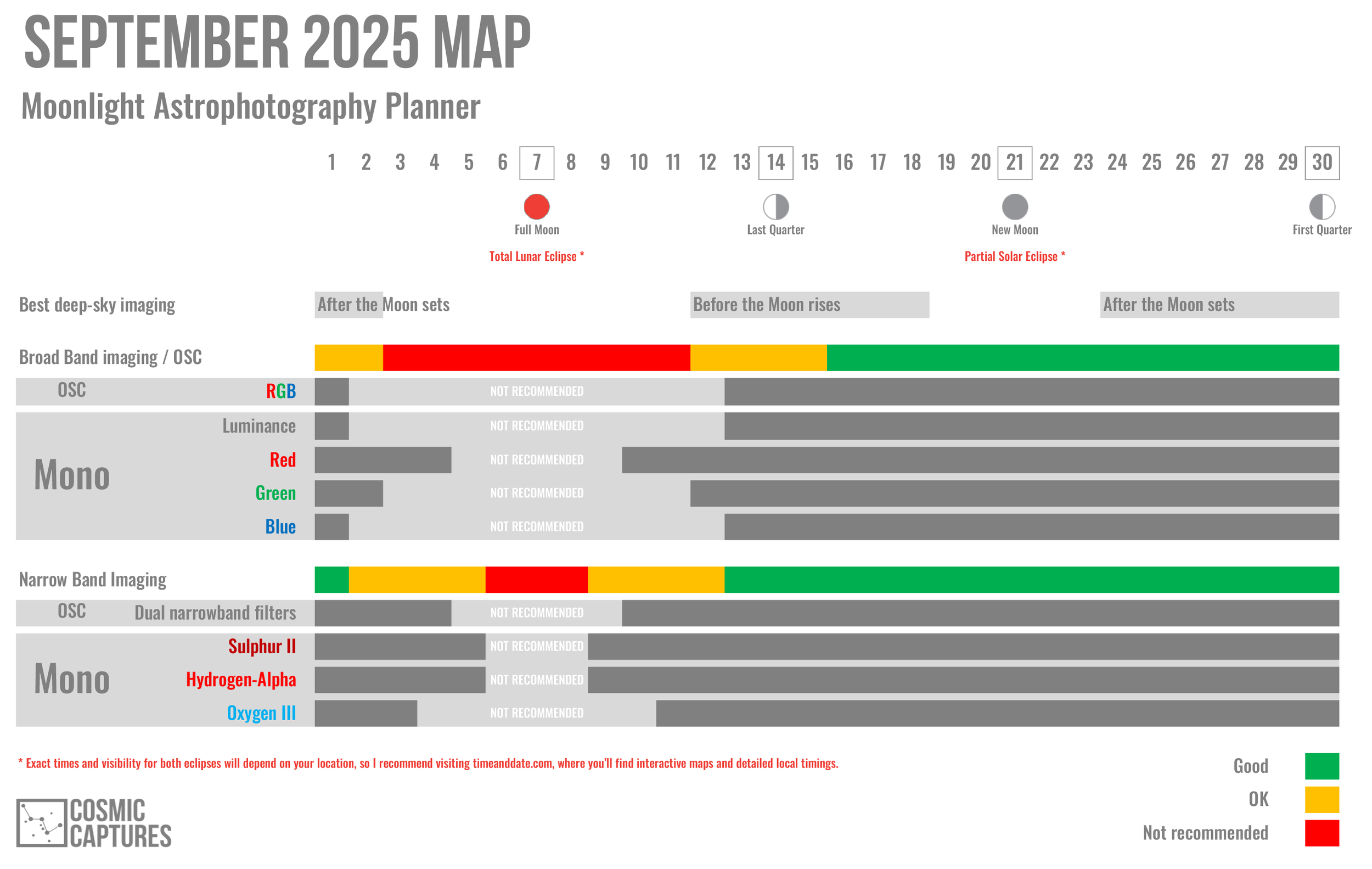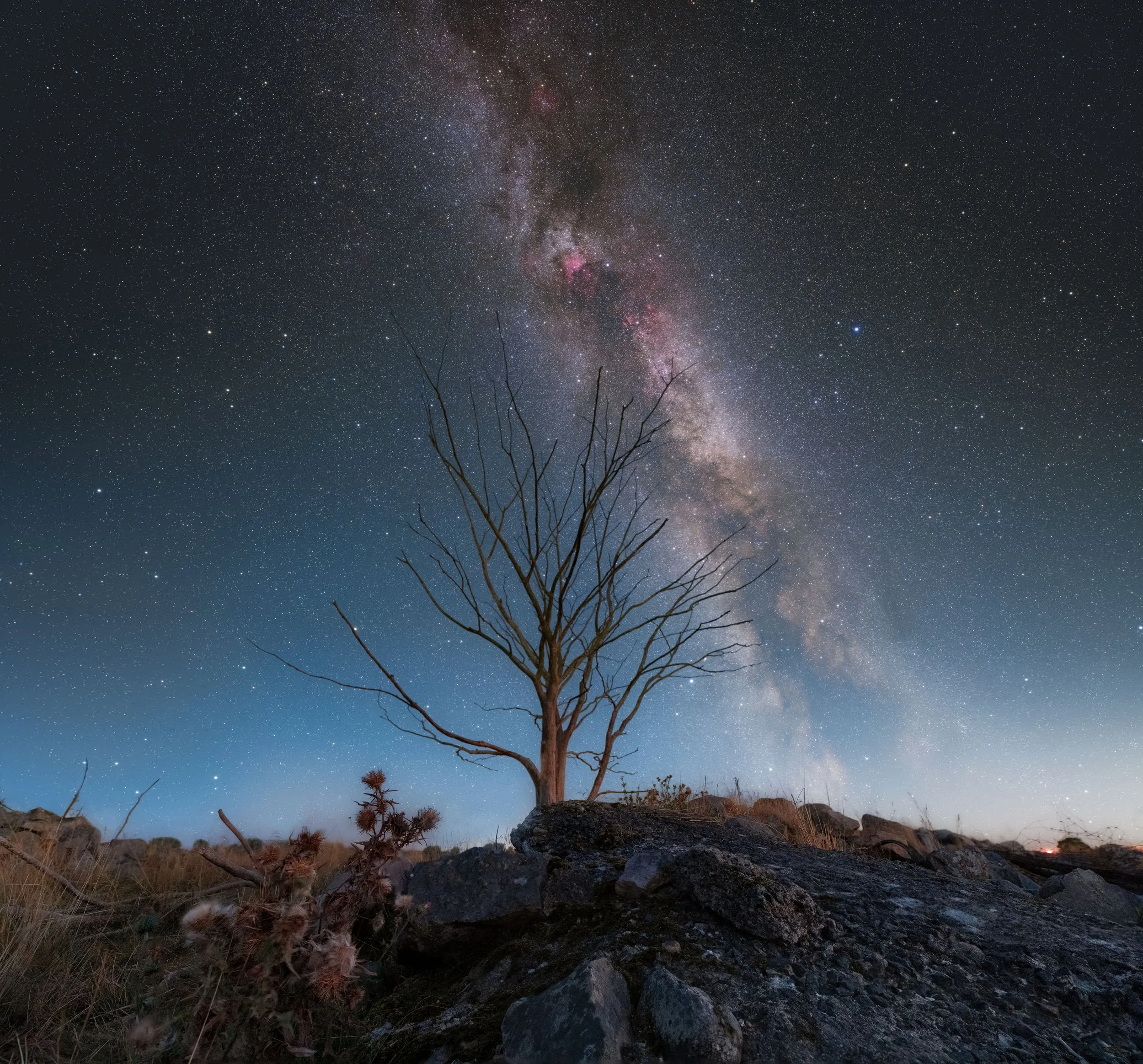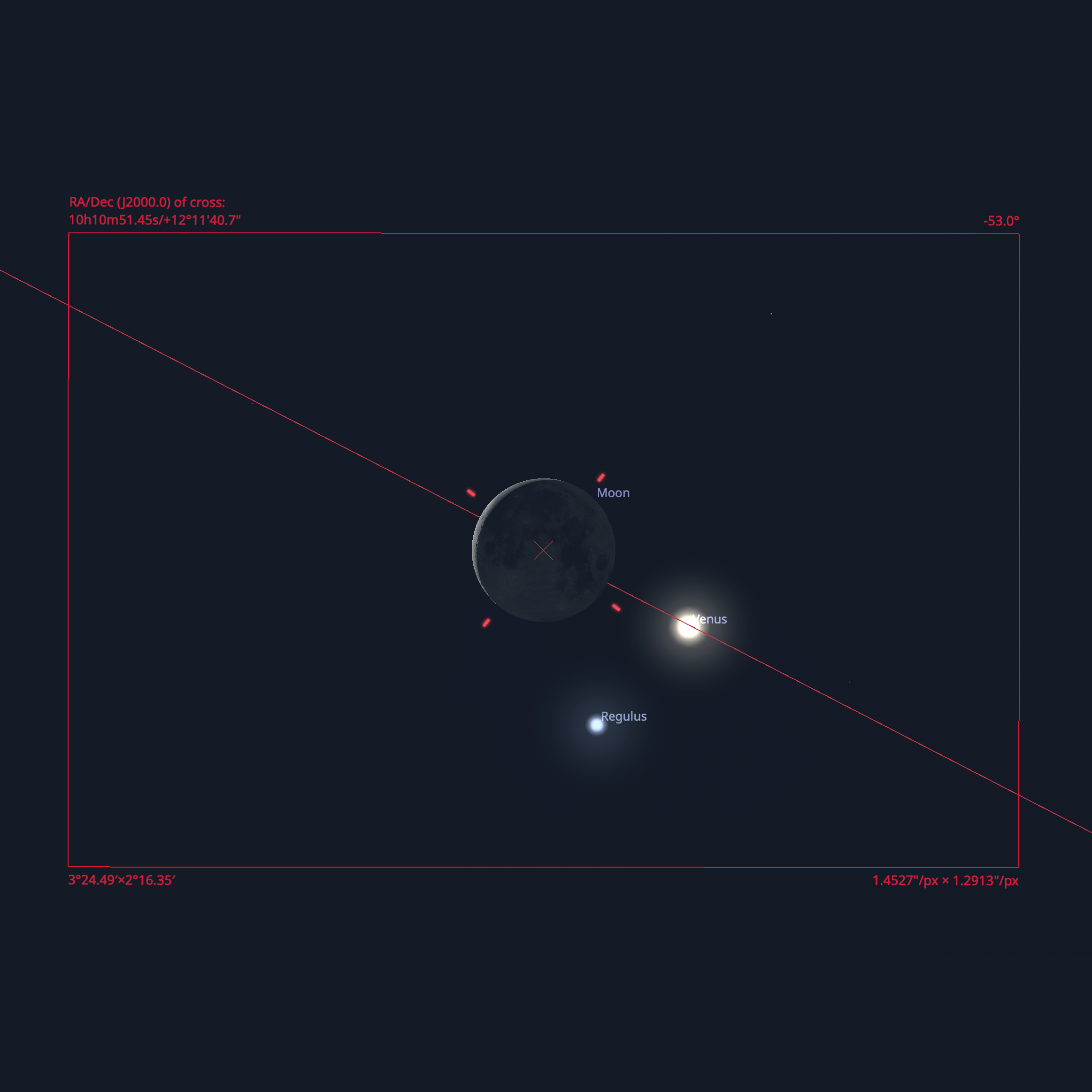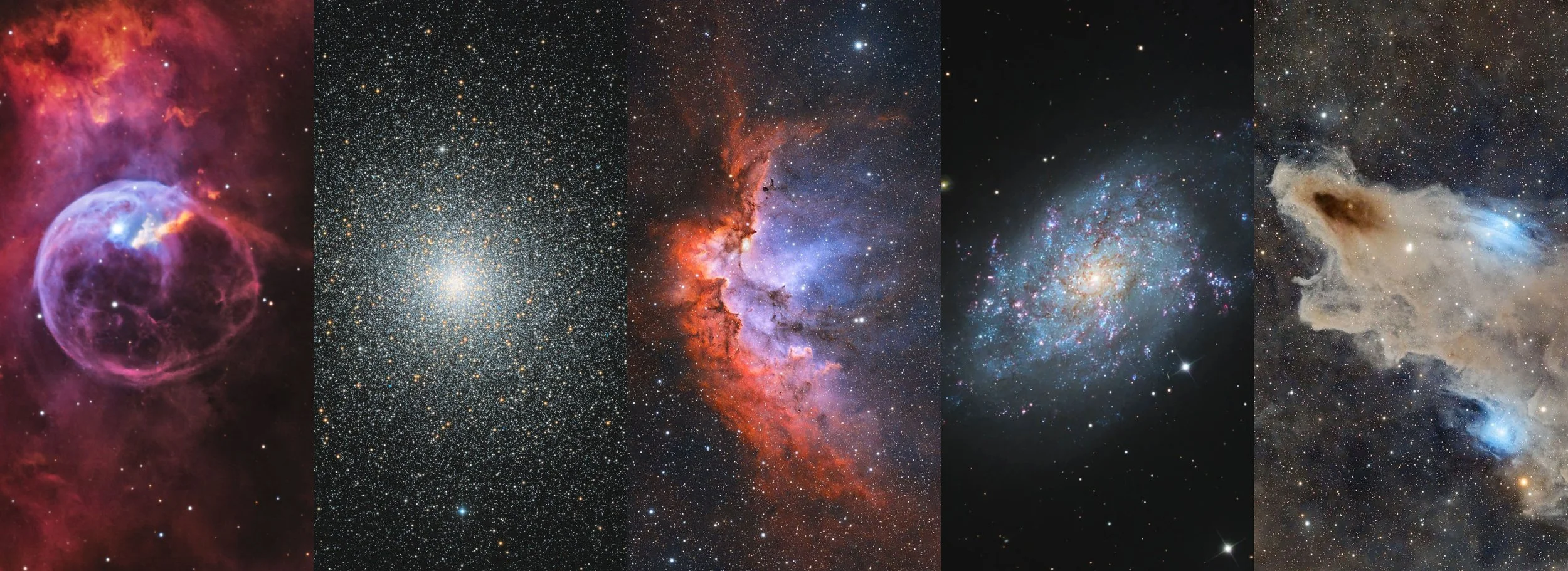
SEPTEMBER 2025
When the Sky Turns a Page.
September is a month of transition. The Milky Way still arches brightly across the night, but its great summer constellations begin to drift westward, making room for what’s to come. In the north, Cassiopeia now rides high, bringing with it nebulae and dark clouds that signal the start of the autumn sky. Look lower toward the horizon at midnight, and you can already catch the first stars of winter quietly arriving.
In the south, the Milky Way tips toward the west as galaxy season begins to rise. The Sculptor group takes its place in the sky, while 47 Tucanae and the Magellanic Clouds shine as steady companions. It’s a different kind of richness—less about the crowded star fields of summer, more about the depth and variety of galaxies and clusters on display.
September feels like the sky is turning a page, offering a glimpse of two seasons at once: the last glow of summer and the first promise of winter.
The September Night Sky at a Glance
Northern Hemisphere Sky – Midnight at New Moon (at +30° latitude)
This is the September night sky as it appears around midnight from mid-northern latitudes. The highlighted deep-sky targets—such as the Bubble and Wizard Nebulae in Cassiopeia and the Dark Shark drifting through Cepheus—stand high above the horizon, perfectly placed for dark-sky imaging.
Image from the app Sky Guide
Southern Hemisphere Sky – Midnight at New Moon (at -30° latitude)
From the southern hemisphere, September’s midnight sky centers on the Sculptor region and the Magellanic Clouds. Featured targets include the galaxies NGC 55 and NGC 7793, along with the brilliant globular cluster 47 Tucanae—rising into prime position.
Image from the app Sky Guide
At midnight on the new Moon, these targets stand close to the meridian—their highest point in the sky. That makes them visible all night long and ideally positioned for imaging. The charts below give a general view of where to find them in the northern and southern skies.
Deep-Sky Targets in September
September marks the shift from summer to autumn skies. In the north, Cassiopeia now rides high, bringing nebulae like the Bubble, the Wizard, and the Dark Shark into perfect view. These targets are rich in detail but faint enough to reward long exposures under dark skies.
In the south, the Milky Way tilts westward and galaxy season begins. The Sculptor group rises with edge-on spirals like NGC 55 and NGC 7793, alongside the brilliant star cluster 47 Tucanae beside the Magellanic Clouds.
Below, you’ll find a visual overview and key info for each target.
For full framing advice, exposure tips, and filtration suggestions, download this month’s Cosmic Astrophotography Planner (CAP) as a free PDF using the button below.
SH 1-109 & NGC 7635 – The Lobster Claw and Bubble Nebula
Constellation: Cassiopeia | Distance: ~7,100 light-years | Apparent Size (Bubble): ~15′ × 8′ | Apparent Magnitude: ~10.0
The Bubble Nebula (NGC 7635) is exactly what it sounds like — a glowing bubble of gas in space. It was created by the powerful stellar wind from a massive, hot star about 40 times the Sun’s mass. This wind pushes into the surrounding gas and dust, carving out a shell roughly seven light-years wide. The star at its heart is so bright and energetic that it makes the bubble’s edge glow in shades of red and pink.
Just to the side lies SH 1-109, also called the Lobster Claw Nebula. It’s part of the same vast cloud of gas but has a very different shape — more like a curled claw of glowing hydrogen. Together, these two nebulae create a spectacular and colourful scene that’s especially striking in narrowband filters, which highlight their intricate structures.
Best for: Narrowband or broadband imaging. A field of view between 1.2° and 1.5° will capture both nebulae with surrounding star fields. Narrowband imaging reveals fine textures in the bubble and bright arcs in the claw, while broadband shows the full mix of gas, dust, and stars.
Image by Cosmic Captures
Sh2-142 – The Wizard Nebula
Constellation: Cepheus | Distance: ~8,500 light-years | Apparent Size: ~15′ across | Apparent Magnitude: ~7.2
This is a glowing cloud of gas and dust that frames a very young cluster of stars known as NGC 7380. The cluster—discovered by Caroline Herschel in 1787—is thought to be only 4–12 million years old, making it a stellar newborn in cosmic terms. At its heart lies a powerful duo: two massive O‑type stars called DH Cephei, whose intense radiation lights up the surrounding gas and even pushes it into sculpted arcs and ridges .
Together, the Wizard Nebula and its star cluster tell a vivid tale of star birth—this isn’t just a pretty picture, it’s a snapshot of how massive young stars shape their cosmic nursery. Narrowband filters are especially effective here, revealing dramatic red glows of ionised hydrogen and fine dusty structures that give the nebula its enchanting “wizardly” character.
Best for: Narrowband imaging (like Hα/OIII/SII), or broadband with strong contrast. A field of view around 1°, approximately twice as wide as a full Moon, captures both the nebula beautifully, with room for detail and framing.
Image by Cosmic Captures
LDN 1235 – The Dark Shark Nebula
Constellation: Cepheus | Distance: ~1,100 light-years | Apparent Size: ~2°–3° across | Brightness: Very faint (low surface brightness)
The Dark Shark Nebula, officially cataloged as LDN 1235, is a cloud of interstellar dust that blocks the light of background stars. Unlike bright emission nebulae that glow from excited gas, dark nebulae are visible only because they hide the stars behind them. In long exposures, this particular dust cloud takes on a familiar form: the silhouette of a shark gliding through a sea of stars.
At its core lies a dense region of dust, and along its edges you’ll find two faint reflection nebulae (vdB 149 and vdB 150). These appear blue because nearby hot stars are scattering their light off the dust particles—similar to how Earth’s sky looks blue in daylight. The surrounding haze also shows hints of red from faint emission, adding depth to the scene.
This nebula isn’t bright—it’s one of those targets that demands dark skies, long integration times, and patience. But the payoff is worth it: the final image often feels less like a photo of a single object and more like a cinematic landscape, where shapes and shadows emerge slowly from the cosmic night.
Best for: Wide-field broadband imaging. A field of view around 2°–3° frames the entire shark shape, along with its subtle blue reflection nebulae. Long exposure times are essential to bring out the faintest dust and detail.
Image by Cosmic Captures
NGC 55 – The String of Pearls Galaxy
Constellation: Sculptor | Distance: ~6.5 million light-years | Apparent Size: 32′ × 5′ | Apparent Magnitude: 7.9
NGC 55 is a barred spiral galaxy seen almost edge-on, about 6.5 million light-years from Earth. It is one of the nearest galaxies outside the Local Group and a prominent member of the Sculptor Group of galaxies.
Its long, thin shape and scattered star-forming regions have earned it the nickname “String of Pearls Galaxy.” Through a telescope it appears as a faint, elongated glow, but in photographs its dusty disk reveals striking pink emission nebulae and clusters of hot blue stars. These pearls of light mark places where new stars are being born.
Because of its proximity, astronomers study NGC 55 as a laboratory for understanding how galaxies form and evolve. For astrophotographers, it offers the rare chance to capture a galaxy in great detail — showing both the large-scale structure of its disk and the fine knots of star formation within it.
Best for: Broadband LRGB imaging. A field of view around 0.8°–1.2° frames the galaxy nicely with surrounding star fields. Adding H-alpha can enhance the delicate regions of active star formation that give the galaxy its “string of pearls” appearance.
Telescope.live image data edited by Cosmic Captures
47 Tucanae (NGC 104) – The Great Cluster Beside the Small Magallanic Cloud
Constellation: Tucana | Distance: ~14,500 light-years | Diameter: ~44′ | Apparent Magnitude: 4.1
47 Tucanae is one of the sky’s brightest and most beautiful globular clusters. Second only to Omega Centauri in brilliance, it shines clearly to the naked eye from dark southern skies. With hundreds of thousands of stars packed tightly into a sphere, it looks like a glowing swarm suspended beside the Small Magellanic Cloud—a pairing that makes this region of the sky unforgettable.
In photographs, the cluster’s dense core seems almost solid with starlight, while the edges gradually fade into a delicate halo. Careful imaging reveals a mix of star colors—cooler orange giants and hotter blue stars—painting a picture of stellar evolution in action.
For astronomers, 47 Tuc is more than just pretty. It’s a treasure chest of exotic stars, including dozens of ultra-fast pulsars and white dwarfs drifting away from the crowded core. For astrophotographers, it’s both a stand-alone showpiece and a perfect wide-field companion to the Small Magellanic Cloud.
Best for: Broadband imaging. A field of view around 1° frames the cluster beautifully. Wider lenses (85–200 mm) can capture the cluster together with the Small Magellanic Cloud for one of the southern hemisphere’s most iconic pairings.
Telescope.live image data edited by Cosmic Captures
NGC 7793 – The Flocculent Spiral in Sculptor
Constellation: Sculptor | Distance: ~12 million light-years | Apparent Size: 9′ × 6′ | Apparent Magnitude: 10.0
NGC 7793 is a spiral galaxy with a softer, patchier look than the classic grand spirals. Astronomers call this type flocculent, meaning its spiral arms appear broken into fluffy segments instead of clean, sweeping curves. At around 12 million light-years away, it is one of the brightest members of the nearby Sculptor Group of galaxies.
In long-exposure images, its disk shows a rich mix of young blue star clusters, pink emission nebulae where stars are forming, and a scattering of older yellow stars. Despite being relatively small and faint compared to showpieces like Andromeda, NGC 7793 rewards patient imaging with surprising detail.
It also hides something remarkable: inside its disk astronomers have discovered a rare microquasar, a system where a black hole or neutron star blasts out jets so powerful they’ve carved a bubble of hot gas nearly 1,000 light-years across. This makes NGC 7793 not only photogenic, but also scientifically fascinating.
Best for: Broadband LRGB imaging. A field of view around 0.3°–0.5° frames the galaxy well. Adding H-alpha can bring out the delicate star-forming knots scattered along its arms.
Telescope.live image data edited by Cosmic Captures
The main Moon Phases in September 2025
Planning your imaging sessions? The Moon plays a massive role in what we can capture.
Here’s what’s happening this month:
Full Moon & Total Lunar Eclipse – September 7–8
This is the Harvest Moon, and during this full Moon, there will be a total lunar eclipse visible across the Americas, Europe, Africa, Asia, and Australia.
At maximum eclipse, the Moon will appear deep red as it passes fully into Earth’s shadow. Check timeanddate.com for exact timings.
Last Quarter
September 14
Deep-sky imaging is best in the first half of the night before the Moon rises in the early morning hours.
New Moon & Partial Solar Eclipse – September 21
The darkest skies of the month arrive with the New Moon, ideal for deep-sky imaging.
On the new Moon, there will also be a partial solar eclipse visible across South America, parts of Antarctica, and the South Atlantic.
Observers in the eclipse path will see the Moon cover part of the Sun—never view this without a proper solar filter.
Check timeanddate.com for exact timings.
First Quarter
September 30
Deep-sky imaging is best after midnight.
Also great for capturing lunar surface details with strong shadows along the terminator.
September 2025 MAP
(Moonlight Astrophotography Planner)
Each month, the MAP — or Moonlight Astrophotography Planner — helps you choose the best nights for capturing galaxies, nebulae, and nightscapes. Whether you’re shooting broadband or narrowband, MAP gives you clear guidance based on the Moon phase, so you can match your imaging plans to the sky conditions.
You can download this month’s MAP as a free PDF using the button below. It’s updated monthly to help you make the most of your imaging time, no matter your style or setup.
Nightscape Opportunities
In the Northern Hemisphere, September marks the shift from summer to autumn skies. The Milky Way still stretches boldly overhead, but the core sinks earlier each evening, making this one of the last chances to capture its full brightness. Later in the night, the summer arch tilts lower toward the horizon while the Pleiades and Hyades rise higher in the east, hinting at the approach of winter constellations.
In the Southern Hemisphere, the Milky Way continues to dominate the early night, but the slow transition toward galaxy season becomes clear. Sculptor and Tucana climb higher, bringing with them the first opportunities to frame landscapes against the Magellanic Clouds and bright southern galaxies.
September is a month of changing rhythms—a blend of summer’s fading glow and the first signs of the seasons ahead.
Use the Moonlight Astrophotography Planner (MAP) to find your best times and nights for moonless imaging — it’s free and updated monthly.
Moon–Venus–Regulus Conjunction
19 September (best at ~16:00 UTC)
So far, I haven’t covered conjunctions on Cosmic Captures — but this one is special, and very photogenic. A razor-thin waning crescent Moon lines up with brilliant Venus and Regulus in a compact pre-dawn triangle. Look low in the E–ENE about 45–60 minutes before sunrise; binoculars help reveal the Moon’s ghostly earthshine.
Best visibility
Pre-dawn on 19 Sep: Hawai‘i (USA), French Polynesia (incl. Tahiti), Cook Islands, American Samoa, Niue.
Pre-dawn on 20 Sep (local date): New Zealand, Fiji, Samoa (not American Samoa), Tonga, Tokelau, Kiribati, Marshall Islands, Tuvalu, Wallis & Futuna, and far-eastern Russia (Kamchatka/Chukotka).
This is a fantastic photo opportunity for DSLR or mirrorless cameras paired with a 400–600 mm telephoto lens on a full-frame sensor. All you need is a solid tripod to keep everything steady and sharp.
Note: In a narrow Arctic zone (parts of northern Canada and Greenland) the Moon actually occults Venus; timing varies by location.
Simulated field of view with a 600 mm lens on a full-frame camera
(Stellarium, 19 September ~16:30 UTC)
Other Highlights in September
September Equinox – 23 September
On the 23rd at 02:20 UTC, the Sun crosses the celestial equator, marking the September equinox. Day and night are nearly equal across the globe. In the north, this is the start of autumn, while in the south, spring begins.
Stellarium-web.org simulation
Saturn at Opposition – 21 September
Saturn reaches opposition on the 21st, rising at sunset and shining bright all night long. This is the best time of year to observe or photograph the ringed planet, as it’s at its closest and brightest for 2025.
The rings are tilted almost edge-on to Earth this year — offering a rare perspective where Saturn’s moons and subtle atmospheric bands become even more prominent.



